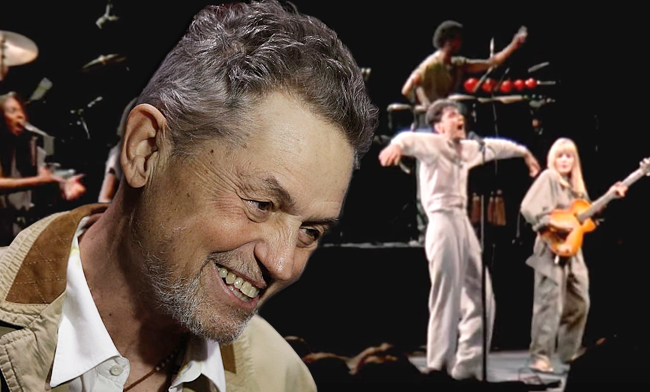
It’s not that Jonathan Demme lacked for moods. It’s that he conspicuously lacked the blue part of the spectrum.
From the first time we met in 1977 at the New York Film Festival, where he premiered the uproarious Citizens Band (retitled Handle With Care), to our last phone exchange about a year ago, his temperament was consistently rosy. In the entitled Hollywood universe, nearly every conversation with this supremely unassuming mensch (born and based in New York) touched upon his gratitude to be a working director, one who worked in every genre from comedy to musical to horror, without ever repeating himself.
Whenever we spoke, what I heard first was his enthusiasm. How tasty the scrapple was at his favorite Amish farmstand; how awesome Neil Young was at Toronto’s Massey Hall; how lovely was Thandie Newton (star of his Charade remake, The Truth About Charlie), and wasn’t she the reincarnation of Audrey Hepburn?
If you’ll forgive me from shifting from first-person to third:
The truth about Jonathan is that when he communicated his enthusiasm, he elicited yours. It’s palpable in his movies, from the earliest shaggy comedies Melvin and Howard and Married to the Mob. In both movies oddballs — a service-station operator and billionaire Howard Hughes in one, an FBI agent and a mob widow in the other — start talking and become closer by recognizing their similarities rather than being divided by their differences. Their communication begets a new community.
Similarly such unexpected, and unexpectedly fruitful, conversations are the centerpieces of Jonathan’s best-known films, The Silence of the Lambs and Philadelphia. In the former, a serial killer and an FBI trainee become unlikely confederates in hunting down a second serial killer. In the latter, an HIV-positive white-shoe attorney unfairly dismissed from his firm persuades a homophobic African-American lawyer to represent him after both men recognize that the intolerance of others has not let them be fully seen.
On paper, these plots read like standard opposites-attract scenarios. But they’re directed with a filmmaker’s eye and a humanist’s heart. For Jonathan’s first-person camera work — often executed by Tak Fujimoto, his favorite cinematographer — revealed what the world looked like from the perspective of each imagined opposite. Not only did Jonathan walk miles in his characters’ shoes, or so it seemed as the camera dogged Jodie Foster’s Clarice Starling down the long corridors of hospital for the criminally insane, but also showed how she recoiled from Lecter’s steel-blue stare.
How many filmmakers look at their characters as Jonathan did? Think of how Starling and Anthony Hopkins’ Lecter size each other up. Think of Tom Hanks and Denzel Washington establishing their relationship in Philadelphia. Or of how Rosemarie DeWitt and Anne Hathaway, as estranged sisters, circle each other in Rachel Getting Married. Jonathan’s attention to faces both gives us the pleasure of getting up close and personal with stars as it simultaneously gets us into the characters’ supercharged emotional spaces.
I could talk volumes about how Jonathan’s movies worked because he empathized with his characters. I could write a dissertation about how he was the rare filmmaker of the New Hollywood generation (think Francis Coppola, Brian De Palma and Martin Scorsese) who imagined a world in which women have active rather than passive roles. I could hold forth about how he gave Melanie Griffith, Jodie Foster, Oprah Winfrey and Anne Hathaway their most challenging parts, respectively in Something Wild, Lambs, Beloved, and Rachel Getting Married. I could talk about his bottomless empathy, about how profoundly he connected with his characters and thus made it easy for the audience to connect with those unlike themselves. (In this, he actively challenged the Hollywood assumption that moviegoers go to the movies to see people who look like them.)
To talk about those at greater length would miss mentioning Jonathan’s extraordinary ear. His rock-docs and pop-docs include Stop Making Sense with Talking Heads, Heart of Gold with Neil Young and Justin Timberlake + the Tennesee Kids with JT himself. Each used the performer’s music to suggest a biography, telling a story bigger and more affecting than the individual songs. In his fiction films he used surprising music to reveal his characters’ inner lives. For instance, Paul Le Mat and Jason Robards, Jr. singing “Bye, Bye Blackbird” to joyous effect in Melvin and Howard or Tom Hanks lip-synching Maria Callas’ aria “La mamma morta” from the opera Andre Chenier in Philadelphia.
Yesterday when I heard that Jonathan had died, age 73, from esophageal cancer, I imagined an intimate sendoff, like that of the Tom Hanks character in Philadelphia, with friends and family listening to the music Jonathan loved while watching home movies of him as a child. Fat chance, said our mutual friend, Richard Abramowitz, who distributed several of his films.
In order to hold everyone who felt close to Jonathan,“They will have to hold his memorial at Yankee Stadium.” So true. Only a venue of that size could accommodate Jonathan’s big heart and his big-tent sympathies.
Carrie Rickey was a long-time film critic at The Philadelphia Inquirer. You can read her work a carrierickey.com






